The chills and charms of Arctic surfing
Unstad, Norway, March 18, 2016 -- When you think about surfing, you think of warmth, sun and sand. Snow, cold and Northern Lights are not the first things to come to mind. So when I heard about surfing in the Arctic, I knew it would make a great story. Turns out a surfer who rides a wave in icy cold water is no different from a surfer in Hawaii. The spirit is the same.
I first came to Norway to watch Arctic surfing last year. I spent four days on Unstad Beach, in the country’s northern Lofoten Islands. They are about 200 km from the polar circle. However, it was mid-April by then and most of the snow had already melted. I wanted to come back when it was still winter, when snow covered the landscape.
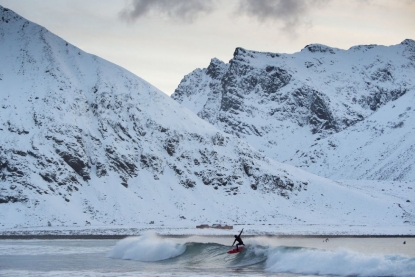 (AFP / Olivier Morin)
(AFP / Olivier Morin)I’ve been here for 10 days now, living in a little cabin in the woods, surrounded by fields and mountains. The winters here are not as bad as people think. I lived in Scandinavia for two years working as AFP’s photographer there so I’ve gotten used to it. Plus, it doesn’t get that cold on Norway’s western coast thanks to the Gulf Stream, the warm current that crosses the Atlantic and laps the coast. The temperature hovers around -1 or -2 Celsius but can drop to -10C with the biting wind. The water stays at about 5C. It climbs to about 12C in the summer.
Decades-long tradition
Cold-weather surfing has been around in Norway since at least 1962. I met the surfer who introduced the idea to the archipelago last year and he’s nearing 70 years old. He and a friend started surfing with boards made of Styrofoam and wet newspaper. So it’s definitely not a new phenomenon.
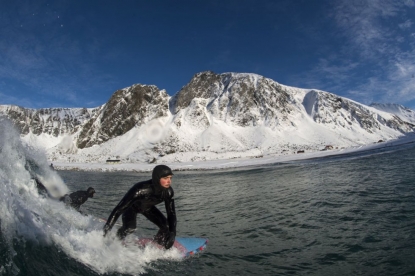 (AFP / Olivier Morin)
(AFP / Olivier Morin)This area has become a great surf spot for many enthusiasts and pros alike, especially in the past few years. It’s become more and more popular because of its excellent, world-class waves. They are similar to what you would find in warm-weather Florida in the United States or in southwest France.
Arctic surfing has many fans, especially when the days start to lengthen. In the mornings, there may not be a lot of people out on the waves, but it starts to pick up toward the late afternoon, around 4:00 and 5:00 pm. There are lots of people in the water around 7:00 pm. As soon as they get off work, many locals head to the ocean. It’s part of the culture here. There are at least five or six really good spots that I know of.
The sport attracts its fair share of women. On a recent day, the ocean was full of women learning to surf as the temperatures hovered near -3C and -4C.
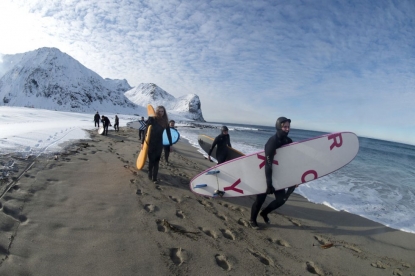 (AFP / Olivier Morin)
(AFP / Olivier Morin)I wanted to maximize my time here in Norway so I set out to explore as soon as I landed. I needed to figure out the terrain so I started out walking in the snow, virtually in the middle of nowhere. There was nothing around me. The weather changes fairly quickly here so it’s a bit problematic for a photographer. You can experience four different weather patterns in one day. It’s not easy to prepare for something like that. And you have to keep the temperature in mind as well.
Bread and liquid yogurt
Most days, I have been getting up at 5 or 6 in the morning and the first thing I do is check the day’s weather to figure out what spots I think will work for photos. Then I have to carefully bundle up in several layers against the freezing cold.
Since I do a fair amount of walking – sometimes I stay outside for nearly 14 hours -- I have to make sure to put on hand and leg warmers, gloves, and of course a balaclava. Then I gather my photo gear, which includes three DSLR cameras and one drone camera, six lenses, a light, and a tripod. I have sometimes been gone from 7 in the morning to return only after midnight and often not until 2 or 3 the next morning. The grueling schedule means that I’ve been living on a diet of bread and liquid yogurt.
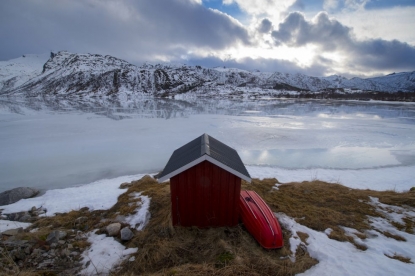 (AFP / Olivier Morin)
(AFP / Olivier Morin)I head out to my first spot to seek out any early-morning surfers. Sometimes, there’s only one person out there depending on conditions. If I like the spot, and the weather seems stable enough -- the wind isn’t too bad and the clouds are few -- and the waves are good, I’ll stay and wait for more surfers to arrive. If not, I’ll move from spot to spot all day to continue to look for good photos. Basically I’m at the mercy of the weather.
I grew up near the ocean, so I’ve been in the water since I was a little boy and am a surfer myself -- I started surfing when I was in my teens but I was focused more on windsurfing at the time. I still occasionally surf today. Because of my experience, when I get in the water to shoot, I know what to expect.
When shooting in the water, I wear a heavy-duty, cold-weather wetsuit with an air-tight hood to keep out water and cold air. I can stay in the ocean for several hours and thanks to the wetsuit, don’t really feel the cold.
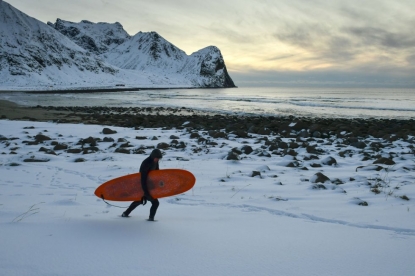 (AFP / Olivier Morin)
(AFP / Olivier Morin)I usually swim out into the ocean with one camera protected by a waterproof case and wait in the water for the perfect shots. I’m about 50 to 80 meters from shore, which isn’t far. I float and tread in the water and around the waves, trying to get as close as possible for a good shot as surfers glide past. I am sometimes within 1 meter to 1.50 meter of the surfer so I have to be very careful to avoid not only the surfer but also from getting caught in the current. It’s demanding physically so you have to be in very good shape.
By the time I get into the water, I’ve set the settings on my camera, so the only thing I have to do is frame my shot and shoot, making sure the light is just right. If I get it wrong, I’m left with a photo in which the water comes out as too white and the waves are also bright white. Too much white in a photo is not pretty, so you have to wait for those gaps in the water that provide good color balance.
Shooting in this climate is actually not that different from shooting in warm weather. The only difference is the cold – particularly if you’re ill-equipped once you’re inside the water. But the waves are the same. The current is the same. The temperature is the only major difference. If your hood slips off your head, you can quickly have a major problem. You have to be able to move seamlessly between the waves, at a moment’s notice, because the waves are always shifting. Being an experienced swimmer here is essential.
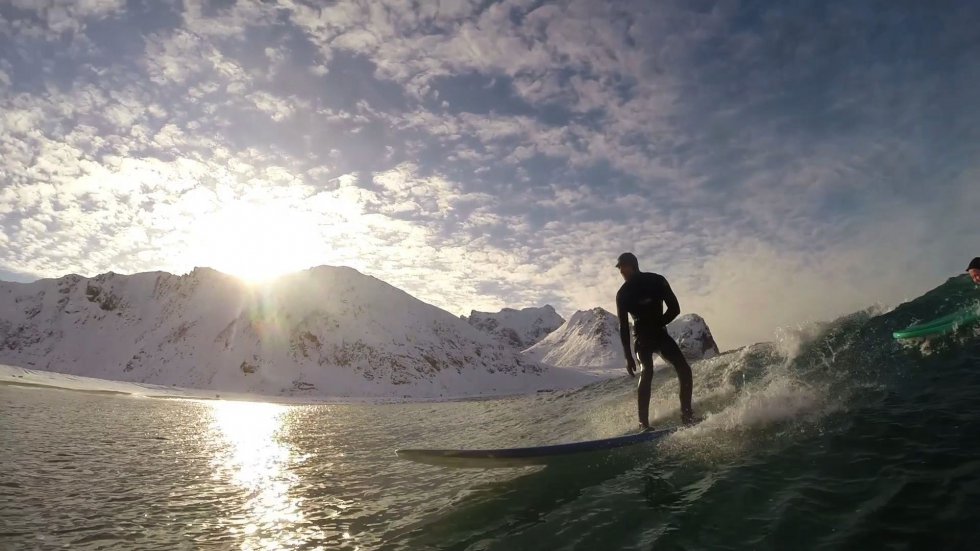
Click here to watch on a mobile device.
I once was overtaken by a wave, thinking I had enough time to avoid it in my pursuit of a shot. I then realized I had miscalculated and the wave had been much closer than I realized. The wave, which measured about 1.50 meters, hit the back of my head and I was plunged underwater for at least 10 seconds. The wetsuit’s hood slipped partly off my face and the frigid water hit my temples.
I didn’t panic because I am used to the water. Still, when that wave hit my head, dislodging the hood, and the water slammed into my face, I felt the violent thermal shock against my temples.
Hawaii covered in snow
Here, your energy is quickly depleted because of the cold temperatures, so you have to stay alert. Obviously, I wouldn’t advise a photographer with no shooting experience in the water to start here, that’s for sure.
This area is a little like Hawaii covered in snow. Hawaii is also surrounded by mountains and towering cliffs. One Australian surfer I met told me he’d never found a spot like this anywhere else in the world. You can surf and then ski right there, on the snowy mountain 200 meters from the beach.
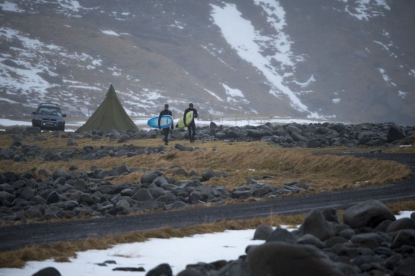 (AFP / Olivier Morin)
(AFP / Olivier Morin)It is the last place you would expect people to look for surfing. But we have all fallen under its charms, including surfers from Australia and California. The water is cold, yes, but it’s surprising how clear it is under the waves. There is definitely a wow factor.
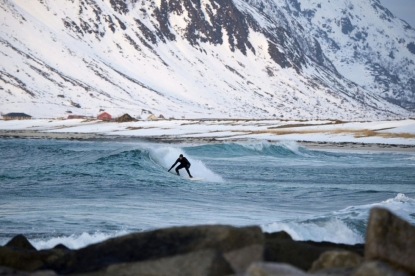 (AFP / Olivier Morin)
(AFP / Olivier Morin)And frankly, if I had to choose between cold or warm-water surfing, I think I would have to go with the cold-water. Yes, it’s hard and can be extreme at times. The wind is biting and can hurt. But when you come out of the frigid water, all you can think about is starting all over again. It’s like a drug. And then there is the sauna. It’s such an ingrained part of the culture here. I head to it along with everyone else and my body is re-energized from the warmth.
Dancing lights across the sky
The first time I stepped outside to explore on this trip, I was awed by the snowy landscape, the snowy mountains and the peaks everywhere. It was really something. It was utterly beautiful. There was nothing around me. Everything was completely silent. My only complaint is that I can rarely capture the scenery as I see it with my own eyes. I wish I could faithfully recreate all the colors of the sky.
There are endless surprises here. I stumbled upon an Arctic weasel near some snow-covered rocks when I first ventured outside. It came very close to me and I was able to shoot off a few shots before it ran away. That proved to be my first encounter on this Arctic trip and it was strangely powerful.
 Arctic weasel. (AFP / Olivier Morin)
Arctic weasel. (AFP / Olivier Morin)I also saw my first Aurora Borealis here. I spent two years in Scandinavia and I had always missed seeing the Northern Lights. I saw them three times on this trip. When the nights fall here, the sky gets clear enough(twilight enough to surf) at just about 10:00 pm. Then, it’s as if someone turns on a light in the sky. It’s breathtaking. And when the colors start to move and dance across the sky, I was filled with euphoria.
Olivier Morin is an AFP photographer based in Milan. Follow him on Twitter and Instagram.
This blog was written with Solange Uwimana in Paris.
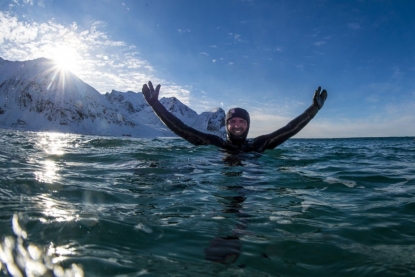 Selfie in the sea. (AFP / Olivier Morin)
Selfie in the sea. (AFP / Olivier Morin)

